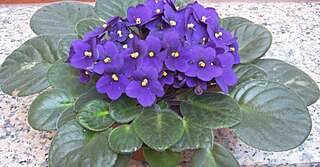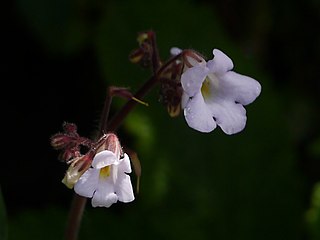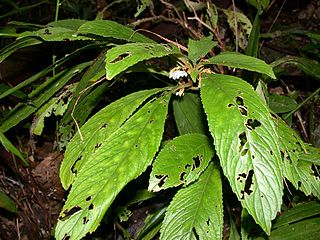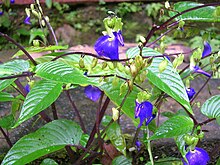
Aeschynanthus is a genus of about 150 species of evergreen subtropical and tropical plants in the family Gesneriaceae. They are usually trailing epiphytes with brightly colored flowers that are pollinated by sunbirds. The genus name comes from a contraction of aischuno and anthos (flower). The common name for some species is lipstick plant, which comes from the appearance of the developing buds emerging from the calyces. A full list of the accepted species and their synonyms can be found in the Smithsonian Institution's World Checklist of Gesneriaceae.

Streptocarpus sect. Saintpaulia is a section within Streptocarpus subgenus Streptocarpella consisting of about ten species of herbaceous perennial flowering plants in the family Gesneriaceae, native to Tanzania and adjacent southeastern Kenya in eastern tropical Africa. The section was previously treated as a separate genus, Saintpaulia, but molecular phylogenetic studies showed that it was nested within the genus Streptocarpus.
Briggsia was a genus in the family Gesneriacae that consisted of 22 species of herbaceous perennials, native to the Himalayas, China and Vietnam. The genus is no longer recognized, with all of its member species having been relocated to other genera, including Glabrella, Loxostigma, and Oreocharis.

Henckelia is a genus of flowering plants in the family Gesneriaceae. Many of its species were formerly placed in Didymocarpus sect. Orthoboea and in the genus Chirita. Many species formerly placed in Henckelia have been moved to Codonoboea and Loxocarpus.
Loxocarpus is a genus of flowering plants in the family Gesneriaceae. It includes 26 species native to Malesia, ranging from southern Thailand to Peninsular Malaysia, Sumatra, and Borneo. Many of its species were formerly placed in the genus Henckelia.

Agalmyla is a genus of plants in the family Gesneriaceae.

Didymocarpus is a genus of flowering plants in the family Gesneriaceae and typical of the tribe Didymocarpeae. There are about 100 known species distributed in India, Nepal, Bhutan, Myanmar, southern China, Vietnam, Laos, Cambodia, Thailand, and the Malay Peninsula, with one species extending up to northern Sumatra. Some members of the genus are known for their medicinal properties, especially to cure diseases related to the kidneys.

Epithema is a genus of plants in the family Gesneriaceae and subfamily Didymocarpoideae. Species range from western tropical Africa to Uganda, tropical and subtropical Asia, and New Guinea.

Rhynchotechum is a genus of plants in the family Gesneriaceae, subfamily Didymocarpoideae. Species distribution records are mostly from India, Sri Lanka, China through to southern Japan, Indo-China and Malesia through to New Guinea.
Paraboea are a genus of flowering plants in the African violet family Gesneriaceae, native to southern China, Assam, Indochina, and Malesia. They were recircumscribed from Boea in 2016.

Damrongia is a genus of flowering plants in the Gesneriad family, centered in Thailand and found in southern China, Southeast Asia, and Sumatra. Species were reassigned to it in 2016 in a revision of Loxocarpinae.
Stauranthera is a genus of flowering plants in the family Gesneriaceae, native to Bangladesh, the Nicobar Islands, Assam, the eastern Himalayas, south-central and southeast China, Southeast Asia, and Malesia to New Guinea. It is very close morphologically and genetically to Loxonia.
Beccarinda is a genus of flowering plants belonging to the family Gesneriaceae.
Boeica is a genus of flowering plants belonging to the family Gesneriaceae. Its native range is Tropical Asia, ranging from the eastern Himalayas to Indochina, southern China, and Peninsular Malaysia.

Cyrtandromoea is a genus of flowering plants belonging to the family Phrymaceae. For a considerable time, the family placement of the genus remained uncertain; it was placed in either Gesneriaceae or Scrophulariaceae. A molecular phylogenetic study published in 2019 showed that it belonged in Phrymaceae.
Didissandra is a genus of flowering plants belonging to the family Gesneriaceae. It includes eight species native to Western Malesia, ranging from Peninsular Malaysia to Sumatra, Java, and Borneo.
Kaisupeea is a genus of flowering plants belonging to the family Gesneriaceae.
Loxostigma is a genus of flowering plants belonging to the family Gesneriaceae.

Ornithoboea is a genus of flowering plants belonging to the family Gesneriaceae. It includes 17 species native to south-central China, Indochina, and Peninsular Malaysia.
Raphiocarpus is a genus of flowering plants belonging to the family Gesneriaceae.












